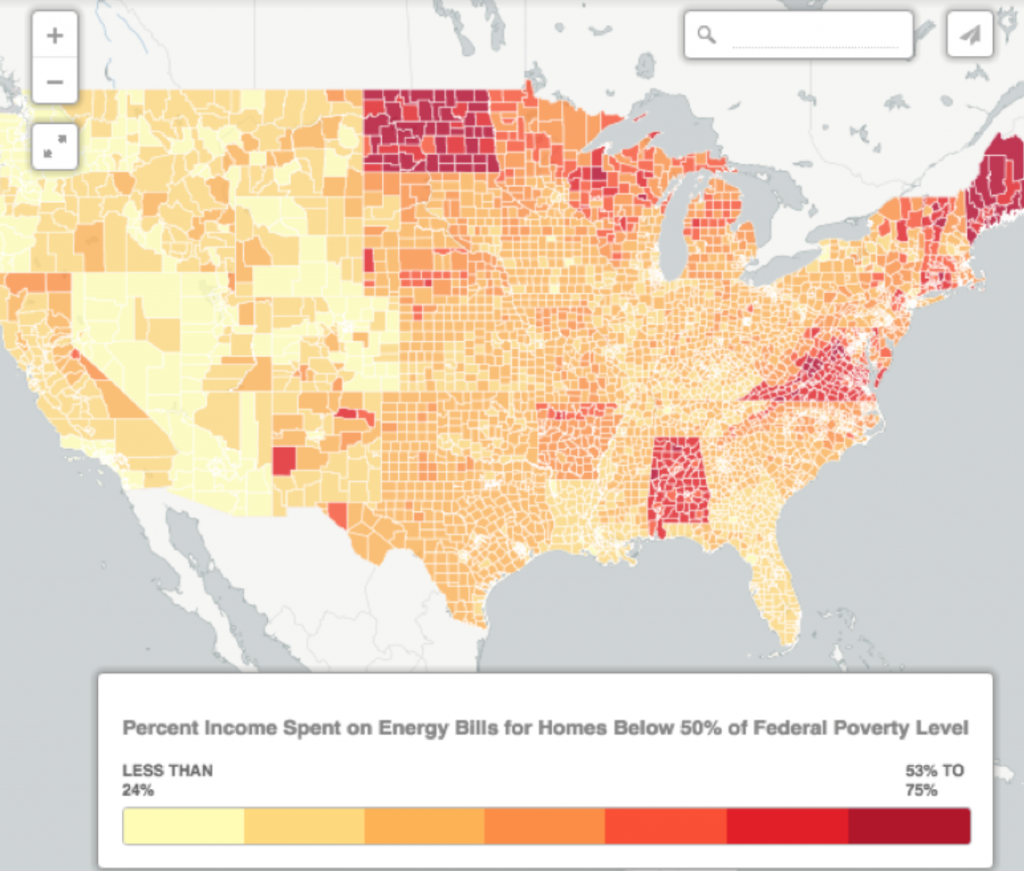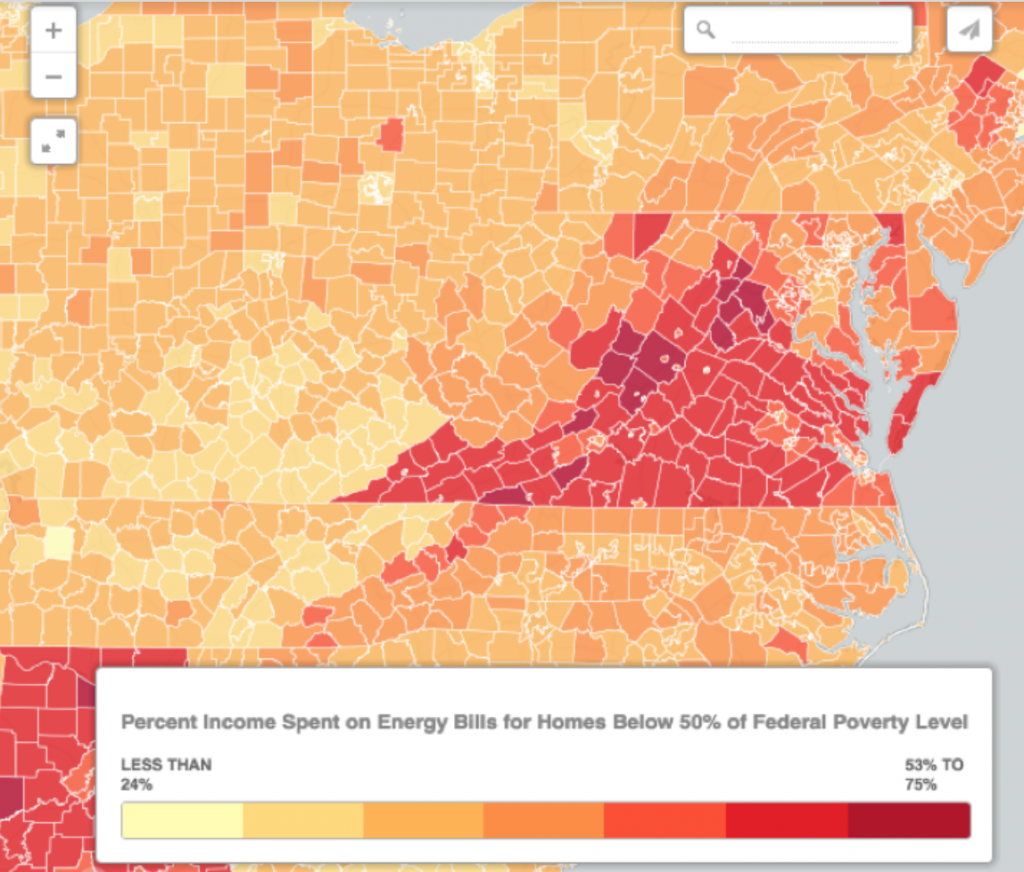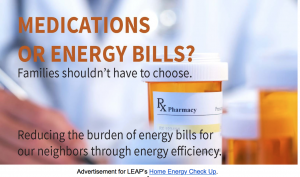With electricity and justice for all
By: Kelsey Galantich, VAEEC Intern 2016
Electricity is essential to remain connected in this day and age. There have even been acts at the international level to make electricity a human right. However, in an article recently released by The Atlantic, even in the United States affordable electricity can be hard to come by.
Most middle to upper class families spend 5% or less of their incomes on energy-related bills.[1] However, according to the article, the lower the income of the family, the higher percentage of income is spent on electricity. Data from the Department of Health and Human Services estimates that people below 50% of the poverty level consequently spend, on average, about 35% of their incomes on home energy costs in the U.S.1
For a better perspective, the map below, created by Inside Energy’s Jordan Wirfs-Brock, compares the percent of income spent on energy bills for homes below 50% of the poverty level within the continental US:

Below, is a closer look at the state of Virginia:[2]

As a solution, Virginia legislators have made efforts to move forward with the federally funded Property Assessed Clean Energy (PACE) financing program. This program allows businesses to finance solar energy and energy efficiency improvements at no upfront cost, and to then pay back the cost over time with the inevitable money saved in energy bills via their property tax bill. The program is slowly moving forward in some Virginia localities, such as VAEEC Council member, Arlington County. However, though available to homeowners in other states, its expansion to private homeowners is not yet a reality in Virginia.
According to the American Council for an Energy Efficient Economy, many state utility regulators require that utilities provide bill assistance programs that complement federal programs, such as the Weatherization Assistance Program (WAP) and the Low Income Home Energy Assistance Program (LIHEAP), both of which are conducted through the U.S. Department of Energy. Some regulations also require utilities with energy efficiency programs to specifically target low-income customers [3]. For example, in Virginia, Dominion Power offers bill pay assistance and free weatherization and energy-saving upgrades through its EnergyShare program, which targets customers facing financial hardships, including military veterans and disabled individuals [4]. The program also includes one-on-one sessions with program participants, and educational outreach at community events to help people make wiser energy decisions. Similarly, another VAEEC member, the Local Energy Alliance Program (LEAP) offers free in-home energy assessments by expert building  analysts for Dominion customers, which are available to households with an income threshold of 60% of the state median income, households with elderly and disabled citizens and Veterans, and Dominion EnergyShare customers. These analysts provide a custom report recommending energy saving products, free installment of selected improvements, and post-installment visits to ensure improvements’ success [5]. Community Housing Partners yet another VAEEC member, located in Christiansburg, VA offers weatherization services through WAP, which involve a site-specific energy audit of the home, along with repairs and improvements, such as the installation of energy-saving measures. This service targets low-income families, in particular those with elderly residents, disabled individuals, and children [6].
analysts for Dominion customers, which are available to households with an income threshold of 60% of the state median income, households with elderly and disabled citizens and Veterans, and Dominion EnergyShare customers. These analysts provide a custom report recommending energy saving products, free installment of selected improvements, and post-installment visits to ensure improvements’ success [5]. Community Housing Partners yet another VAEEC member, located in Christiansburg, VA offers weatherization services through WAP, which involve a site-specific energy audit of the home, along with repairs and improvements, such as the installation of energy-saving measures. This service targets low-income families, in particular those with elderly residents, disabled individuals, and children [6].
Increased energy efficiency is essential to making electricity more affordable and accessible. These national and local initiatives have the potential to help millions of low-income Americans keep the lights on while also staying fed, offering hope for a more efficient, cleaner, and sustainable communities at reduced cost, no matter the income.
Does your utility, nonprofit or company offer programs or opportunities for families in need in Virginia to reduce the burden of their energy bills? Let us know by emailing info@vaeec.org and we’ll update this post!
[1] http://www.theatlantic.com/business/archive/2016/06/energy-poverty-low-income-households/486197/
[2] These maps are based on original analysis by independent firm, Accounting Insights, who shared their data with Inside Energy. The annual energy bills were determined by information regarding energy use, type, and price from the Energy Information Administration, and information on household size, tenure, type of fuel used from the U.S. Census Bureau. This information was compiled into a model that estimated the annual energy cost for each U.S. county. Inside Energy then divided the average annual energy bill by the income midpoint for households living under 50% of the federal poverty level to come up with the percent of income owed to energy bills.
[3] http://aceee.org/sites/default/files/publications/researchreports/u1602.pdf
[4] https://www.dom.com/residential/dominion-virginia-power/in-the-community/energyshare
[5] http://leap-va.org/saveaton/
[6] https://www.communityhousingpartners.org/312/weatherize.html
